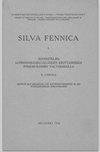Radial growth of trees differing in their vitality in the middle-aged Scots pine forests in the Kola peninsula
IF 1.7
3区 农林科学
Q2 FORESTRY
引用次数: 1
Abstract
The research was carried out in unmanaged middle-aged (75–85 years) Northern taiga Scots pine (Pinus sylvestris L.) forests in the Kola peninsula. It was established that forests of green moss-lichen and green moss site types are characterised by a predominance (65–70% by stand volume) of moderately and strongly weakened trees. Trees of differing vitality have significant differences in annual increment. Healthy trees had a radial increment (RI) 70–75% greater than that of dying trees, and a basal area increment (BAI) 85–90% greater. The dynamics of the RI and BAI of Scots pine trees for the 70-year period (from 1945 to 2015) is different. The RI of all individuals in the communities studied decreases consistently. The decrease is expressed more strongly in green moss Scots pine forests (80–95% from 1945 to 2015) compared to green mosslichen forests (60–80%); it manifests itself more in strongly weakened and dying individuals (75–95%) than in healthy and moderately weakened ones (60–80%). Annual basal area increment in green moss Scots pine forests increases by 45–65% from stand establishment until the trees are 25 to 35 years old and subsequently decreases by 50–80% to 70–80 years of age. In green moss-lichen pine forests the BAI of Scots pine remains rather stable in healthy and moderately weakened trees and decreases in strongly weakened and dying individuals by 45% and 75–80%, respectively throughout the studied period.在科拉半岛的中年苏格兰松林中,树木的径向生长不同于它们的活力
这项研究是在科拉半岛未管理的中年(75-85岁)北针叶林苏格兰松(Pinus sylvestris L.)森林中进行的。结果表明,青苔和青苔立地类型的森林以中度和强烈弱乔木为主(按林分积计为65 ~ 70%)。不同活力树种的年生长量差异显著。健康乔木的径向增量(RI)比枯死乔木大70 ~ 75%,基底面积增量(BAI)比枯死乔木大85 ~ 90%。70年间(1945 - 2015年),苏格兰松树的RI和BAI的动态变化是不同的。所研究社区中所有个体的RI持续下降。与绿色苔藓林(60-80%)相比,绿苔苏格兰松林(1945 - 2015年80-95%)的下降更为明显;严重虚弱和垂死的个体(75-95%)比健康和中度虚弱的个体(60-80%)表现得更多。绿苔苏格兰松林的年基片面积增长量从立林到树木25 ~ 35岁增加45 ~ 65%,随后在70 ~ 80岁期间减少50 ~ 80%。在绿色地衣松林中,健康和中度衰弱个体的白松BAI在整个研究期间保持稳定,而在强烈衰弱和垂死个体的白松BAI分别下降45%和75-80%。
本文章由计算机程序翻译,如有差异,请以英文原文为准。
求助全文
约1分钟内获得全文
求助全文
来源期刊

Silva Fennica
农林科学-林学
CiteScore
3.50
自引率
11.10%
发文量
21
审稿时长
3 months
期刊介绍:
Silva Fennica publishes significant new knowledge on forest sciences. The scope covers research on forestry and forest ecosystems. Silva Fennica aims to increase understanding on forest ecosystems, and sustainable use and conservation of forest resources. Use of forest resources includes all aspects of forestry containing biomass-based and non-timber products, economic and social factors etc.
 求助内容:
求助内容: 应助结果提醒方式:
应助结果提醒方式:


